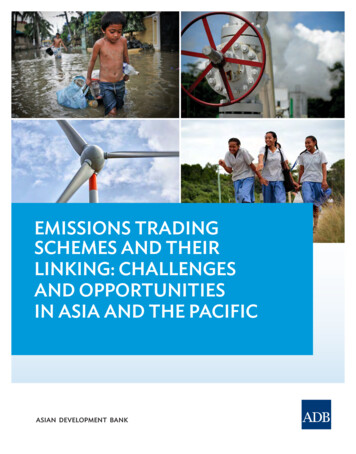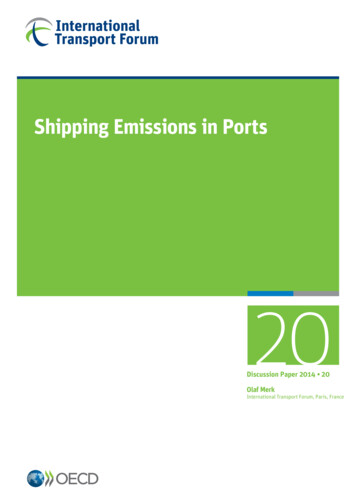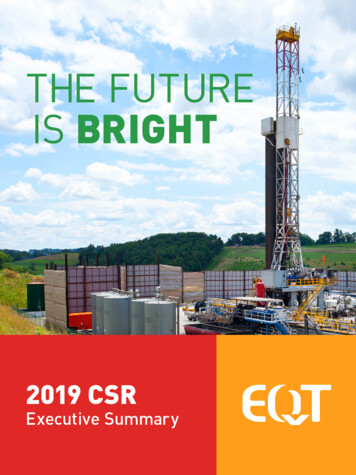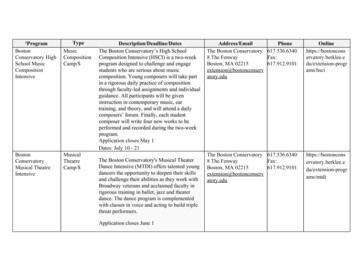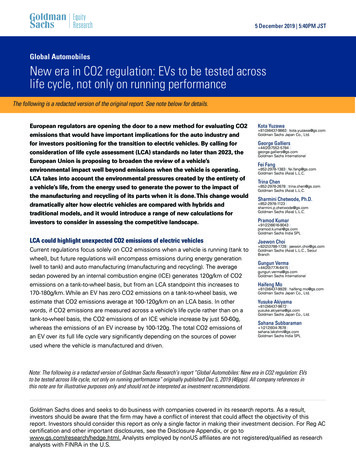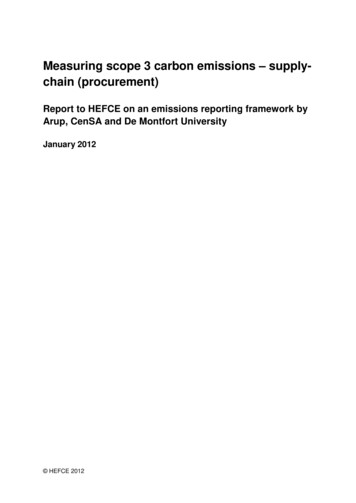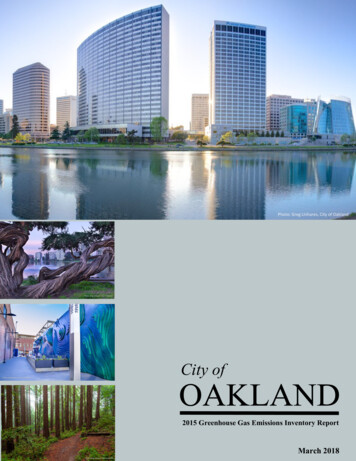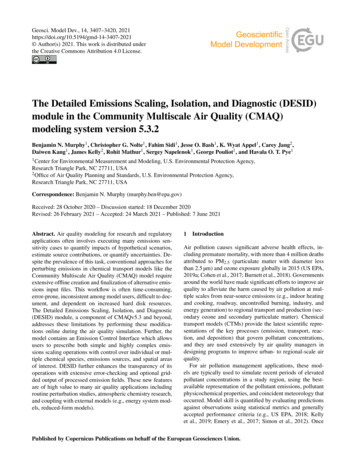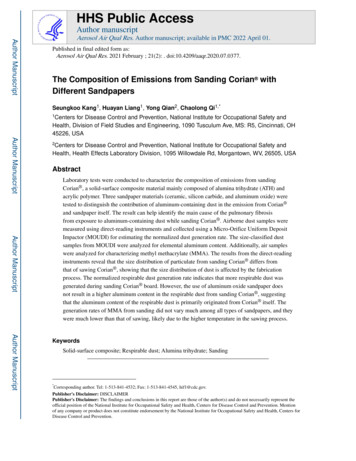
Transcription
HHS Public AccessAuthor manuscriptAuthor ManuscriptAerosol Air Qual Res. Author manuscript; available in PMC 2022 April 01.Published in final edited form as:Aerosol Air Qual Res. 2021 February ; 21(2): . doi:10.4209/aaqr.2020.07.0377.The Composition of Emissions from Sanding Corian withDifferent SandpapersSeungkoo Kang1, Huayan Liang1, Yong Qian2, Chaolong Qi1,*1Centersfor Disease Control and Prevention, National Institute for Occupational Safety andHealth, Division of Field Studies and Engineering, 1090 Tusculum Ave, MS: R5, Cincinnati, OH45226, USAAuthor Manuscript2Centersfor Disease Control and Prevention, National Institute for Occupational Safety andHealth, Health Effects Laboratory Division, 1095 Willowdale Rd, Morgantown, WV, 26505, USAAbstractAuthor ManuscriptLaboratory tests were conducted to characterize the composition of emissions from sandingCorian , a solid-surface composite material mainly composed of alumina trihydrate (ATH) andacrylic polymer. Three sandpaper materials (ceramic, silicon carbide, and aluminum oxide) weretested to distinguish the contribution of aluminum-containing dust in the emission from Corian and sandpaper itself. The result can help identify the main cause of the pulmonary fibrosisfrom exposure to aluminum-containing dust while sanding Corian . Airborne dust samples weremeasured using direct-reading instruments and collected using a Micro-Orifice Uniform DepositImpactor (MOUDI) for estimating the normalized dust generation rate. The size-classified dustsamples from MOUDI were analyzed for elemental aluminum content. Additionally, air sampleswere analyzed for characterizing methyl methacrylate (MMA). The results from the direct-readinginstruments reveal that the size distribution of particulate from sanding Corian differs fromthat of sawing Corian , showing that the size distribution of dust is affected by the fabricationprocess. The normalized respirable dust generation rate indicates that more respirable dust wasgenerated during sanding Corian board. However, the use of aluminum oxide sandpaper doesnot result in a higher aluminum content in the respirable dust from sanding Corian , suggestingthat the aluminum content of the respirable dust is primarily originated from Corian itself. Thegeneration rates of MMA from sanding did not vary much among all types of sandpapers, and theywere much lower than that of sawing, likely due to the higher temperature in the sawing process.Author ManuscriptKeywordsSolid-surface composite; Respirable dust; Alumina trihydrate; Sanding*Corresponding author. Tel: 1-513-841-4532; Fax: 1-513-841-4545, hif1@cdc.gov.Publisher's Disclaimer: DISCLAIMERPublisher's Disclaimer: The findings and conclusions in this report are those of the author(s) and do not necessarily represent theofficial position of the National Institute for Occupational Safety and Health, Centers for Disease Control and Prevention. Mentionof any company or product does not constitute endorsement by the National Institute for Occupational Safety and Health, Centers forDisease Control and Prevention.
Kang et al.Page 2Author ManuscriptIntroductionCorian is a widely used solid-surface composite material that is often used for countertops.Its product overview (DuPont, 2018) specifies that it is mainly composed of about 1/3acrylic resin (polymethyl methacrylate) and about 2/3 alumina trihydrate (ATH). Countertopfabrication processes, including sanding and sawing, may pose an occupational risk forworkers as they are exposed to emissions containing respirable dust and volatile organiccompounds (VOCs). Exposure to these emissions is associated with respiratory andcardiovascular morbidity (Brook et al., 2010). In addition, inhalation of metal dust includingaluminum can cause pulmonary fibrosis (Kelleher et al., 2000; Taskar and Coultas, 2006).Author ManuscriptA pulmonary fibrosis case associated with exposure to ATH dust was reported for a workerwho had worked with Corian (Raghu et al., 2014). However, McKeever et al. (2014) raiseda question whether the main cause of the pulmonary fibrosis was ATH from Corian or thealuminum oxide from sandpapers. In order to find the main cause of the pulmonary fibrosis,we conducted systematic studies as follows. Qi et al. (2016) investigated the emissionsfrom sawing Corian by measuring the size distribution of the airborne dust and aluminumcontent in total airborne and respirable dust samples. The results indicated that ATH wasdominant in both respirable and total airborne dusts, and a large amount of ultrafine particleswas generated. Kang et al. (2019) further studied the emissions from sawing Corian bycollecting size-classified airborne dust samples and analyzing ATH distribution in the dust ofdifferent sizes. For most parts of the respirable size range, the ATH content was above 85%,thus confirming that aluminum in the respirable dust, including ultrafine particles, mainlycomes from Corian .Author ManuscriptIn order to further verify whether sandpaper could contribute significantly to the respirabledust that contains aluminum when sanding Corian , we characterized the dust from sandingCorian using three different sandpaper materials: ceramic, silicon carbide, and aluminumoxide. We collected size-selective airborne dust samples for the measurement of their sizeand the analyses of their aluminum contents. We also conducted analyses of VOCs in theemissions.MATERIALS AND METHODSLaboratory testing systemAuthor ManuscriptWe conducted the laboratory characterization of airborne particles by sanding Corian inan automated laboratory testing system that is described in previous publications (Qi etal., 2016; Kang et al., 2019). Fig. 1 shows a schematic of the system configuration andits operation condition. An air handling unit (PSKB-1440, ProVent LLC, Harbor Springs,MI, USA) was used to generate airflow through a panel of pre- and HEPA filters for theremoval of airborne particles before entering an automatic tool testing chamber. For eachtest, the flowrate in the chamber was set to 0.64 m3 sec–1 by adjusting the blast gatevalve, and a delta tube (306AM-11-AO, Midwest Instrument, Sterling, MI, USA) on theduct monitored the flowrate through the testing chamber. During the test, Corian boardswere automatically sanded by a Porter cable belt sander (Model 352VS, Porter Cable,Jackson, TN, USA) in the chamber using different types of sandpapers. For each sandingAerosol Air Qual Res. Author manuscript; available in PMC 2022 April 01.
Kang et al.Page 3Author Manuscriptpath, a dust cloud was generated and then carried downstream by the airflow through thetesting chamber. The dust cloud was sampled through an isokinetic sampling probes on theduct of the testing system. The system was designed and operated in accordance to theEuropean Standard EN 1093–3 (CEN, 2006) to sample a representative part of the airbornecontaminants in the airflow. The volume flowrate used in this study was sufficient to keepthe inhalable particles remain airborne according to this standard.Belt Sander and SandpapersA Porter Cable belt sander was installed in the testing chamber for all the tests. Sandpapersof three different materials including ceramic, silicon carbide, and aluminum oxide weretested. All tested sandpapers are 7.62 cm (3 inches) by 53.34 cm (21 inches) and had a gritsize of 120 (Red Label Abrasives, MI, USA).Author ManuscriptFor each sanding test, the automatic tool-testing chamber was programmed to performa pre-determined number of sanding pass cycles. Each sanding pass cycle included thefollowing steps: 1) the feed plate fed the board forward; 2) power was supplied to the sander;3) the 2D actuator moved the sander and made a sanding pass across the board; 4) thesander was turned off; and 5) the 2D actuator moved the sander back to its original position.A waiting time about 5 seconds was programmed between steps 2) and 3) to ensure thesander reached the designed speed before making a sanding pass. For each test, sanding wasrepeated more than 150 sanding pass cycles to obtain a statistically reliable amount of data,and new sandpaper was installed before conducting the next test. The operating condition ofthe belt sander remained the same for all experiments.Sampling MethodAuthor ManuscriptThree sets of size-classified airborne dust samples were collected using a Micro-OrificeUniform Deposit Impactor (MOUDI 110, TSI Inc, Shoreview, MN, USA) from a samplingport with a flowrate of 30 L min–1. An isokinetic sampling probe was specifically designedand used for the MOUDI to obtain representative airborne dust samples. The MOUDI wasequipped with pre-weighed PVC filters (47-mm diameter, 5-μm pore-size) and separatesparticulate matter into 12 different stages with the following cutoff points for each stage:18, 10, 5.6, 3.2, 1.8, 1.0, 0.56, 0.32, 0.18, 0.1, 0.056 μm, and a final filter. The mass of thecollected dusts on each filter was determined by post-weighing the filters. After gravimetricanalysis, elemental aluminum analysis of each sample was conducted according to NIOSHMethod 7303 (NIOSH, 2003a).Author ManuscriptIn addition to sampling size-selected dust samples, a Fast Mobility Particle SizerSpectrometer (FMPS, Model 3091, TSI Inc., Shoreview, MN, USA) and an AerodynamicParticle Spectrometer (APS, Model 3321, TSI Inc., Shoreview, MN, USA) were usedto obtain real-time size distributions of the airborne dust from sanding Corian . FMPSmeasures mobility diameter in the size range of 6–523 nm, while APS measuresaerodynamic diameter in the size range of 0.542–19.8 μm. The time resolution during themeasurement was 1 sec, which allowed both instruments to capture the entire dust cloudprofile for each individual sanding pass, and to avoid overlaps of measurements between twoadjacent sanding passes. As shown in Fig. 1, the APS took samples from the duct throughAerosol Air Qual Res. Author manuscript; available in PMC 2022 April 01.
Kang et al.Page 4Author ManuscriptAuthor Manuscriptan isokinetic sampling probe designed for its operating flowrate, while the FMPS used thesampling port and a probe that is designed to take isokinetic sample at 9.0 L min–1. Theoperating flowrate of the FMPS is 10.0 L min–1, so its sampling was anisokinetic. However,the maximum sampling bias (for particles of 523 nm) from the anisokinetic sampling wasestimated about only 0.1% by the equation from Belyaev and Levin (1974). Measurementswere repeated 10 times for each test. In addition, a baseline test with the belt sanderrunning while not sanding Corian was conducted to investigate the particles released fromthe running sander alone. Both APS and FMPS measure number-based size distributionsdirectly. The mass-based size distributions were then obtained by assuming all the particlesare spherical with a known density. The chemical composition of the particles generatedfrom the baseline test was not analyzed so unit density was assumed for them. The analysisof the filter samples suggested that ATH is likely the dominant component of the airbornedust from sanding Corian board, thus the density of ATH (2.42 g cm–3) was used to derivethe mass-based distributions for the dust from sanding Corian board.The previous study on sawing Corian found that methyl methacrylate (MMA) was themost abundant VOC compound in the emissions with a very small generation rate. Thisis not a surprise as MMA’s polymer form, i.e., polymethyl methacrylate is about 1/3 forthe composition in Corian . Therefore, we only sampled MMA from sanding in this studyby collecting air samples in nine XAD-2 sorbent resin tubes (SKC Inc., Eighty four, PA,USA) with three samples for each sandpaper material. The MMA sampling was conductedin accordance with NIOSH Method 2537 (NIOSH, 2003b).Author ManuscriptIn this study, the generation rate is used to compare the data obtained from sampled dust andMMA. The normalized generation rate (G) of airborne contaminants (either dust or MMA)from sanding Corian board is defined as:G Msample QMloss Qsampler(1)where, Msample is the mass of the airborne contaminant from the sample; Q is the volumeflowrate in the testing system; Mloss is the mass of the Corian board that was removedby sanding (obtained by pre-weighing and post-weighing the board); and Qsampler is thesampling flowrate for the samplers used (MOUDI for dust and sorbent tube for MMA). Grepresents the mass of the corresponding airborne contaminant generated per unit of mass ofthe Corian removed from sanding.RESULTS AND DISCUSSIONAuthor ManuscriptDust analysesFig. 2 shows the average particle size distribution measured by FMPS while sandingCorian . Each data point is the averaged result of ten replicates, and each replicate is theaveraged result obtained during the sanding operation of one sanding path cycle. Each errorbar represents the standard deviation of the ten replicates. For the comparison purpose, theaverage particle size distribution from sawing Corian from previous study (Qi et al., 2016)is included. We would like to note that the particle concentrations from sawing Corian Aerosol Air Qual Res. Author manuscript; available in PMC 2022 April 01.
Kang et al.Page 5Author Manuscriptpresented here are slightly higher than those presented in the previous paper, which wasaveraged for the entire operational cycle of a sawing test including the “dead time” betweenthe adjacent two cycles when the particle concentration was close to zero.Author ManuscriptAs shown in Fig. 2(a), baseline tests from both sawing and sanding demonstrate a similartrend. Most particles are smaller than 50 nm, which may be produced mainly from themotors of the power tools under the no-load mode. The number-based size distribution fromsanding is clearly different from that of sawing. The particle concentration from sawingis considerably higher than those from sanding for the particles smaller than about 50 nmwhile it is lower for the larger particles. This result along with the result of baseline testssuggests that the fabrication process (sawing and sanding) indeed affects the size distributionof the generated particles. A smaller difference is observed between the size distributionsfrom sanding using different sandpaper materials, with the concentration from the sandpaperof aluminum oxide being slightly higher than the other two. Compared to the sandingbaseline test, the results shown in Fig. 2(a) suggests that most particles smaller than 30nm are generated from the sander’s motor, and larger particles are from sanding Corian .The mass-based size distribution from sawing Corian plotted in Fig. 2(b) shows a bimodaldistribution with modes of particle sizes at around 29 nm and 191 nm, while the distributionfrom sanding shows a unimodal distribution with a mode at around 191 nm. While theirpatterns in the mode of 191 nm are similar, the highest peak was found from aluminumoxide sandpaper and the lowest was found from sawing and sanding with ceramic sandpaper.Both baseline tests show an almost negligible amount of particle mass.Author ManuscriptAuthor ManuscriptFig. 3 shows the size distributions of particles generated from sanding and sawing measuredby APS. All the data points are averaged from ten replicate measurements, and each errorbar represent the standard deviation of the ten measurements. Both baseline tests shownegligible amounts of particles in the particle size range of the APS. The number-basedsize distributions in Fig. 3(a) show a mode at around 1 μm from both sawing and sandingCorian . Among all the results, the size distribution from sawing shows the lowest numberconcentration while that from sanding with aluminum oxide shows the highest numberconcentration. As shown in Fig. 3(b), the mass-based APS data shows bimodal distributions,while the mode of the smaller particle size is less apparent for the sawing result. The sizedistributions from sanding have the first mode at about 2.5 μm and the second at about7.5 μm. In general, sanding with different sandpaper materials generates similar amounts ofparticle mass in the particle size range of the APS. Compared to sanding, sawing leads tohigher mass concentration for particles larger than about 3 μm and lower mass concentrationfor smaller particles. Please note that the particle concentration levels shown in Figs. 2 and3 can be different from the actual exposure data in practice, as they were obtained from thelaboratory setting, although the shape of the particle size distributions are expected to besimilar.Fig. 4 illustrates the normalized generation rate G of the airborne dust and aluminumelement in the dust generated from sanding and sawing Corian board. The error bars inthe plot are standard deviations of three MOUDI replicates. In general, the G from sawingis considerably lower than that from sanding. The G for airborne particles of different sizesfrom sanding is between 0.2 and 33.4 mg g–1, while that from sawing is between 0.2 andAerosol Air Qual Res. Author manuscript; available in PMC 2022 April 01.
Kang et al.Page 6Author Manuscript3.6 mg g–1. The particle concentration levels illustrated in Fig. 3 have a much smallerdifference between sanding and sawing. The larger difference on G shown in Fig. 4 suggeststhat sanding has a much larger portion of the materials removed from Corian becomingairborne particles compared to sawing. This is consistent with the observation that sawinghad a much larger amount of settled dust in the chamber. A similar pattern is observedamong all the sanding results with their peaks at around 7.5 μm. The G for the ceramicsandpaper is the highest, and that for the aluminum oxide sandpaper is the lowest. Thepattern for the G of aluminum element in the dust shown in Fig. 4(b) is similar to that ofairborne dust in Fig. 4(a), suggesting that the aluminum content does not vary considerablyamong particles of different sizes. By considering the respirable fraction for each MOUDIstage, we derived the generation rate of respirable dust Grd as:Grd Gi f i(2)Author Manuscriptwhere Gi and fi are the dust generation rate and respirable fraction of the ith stage ofMOUDI, respectively.As shown in Table 1, the respirable dust generation rate is 5.9 from sawing and 24.9,32.5, and 20.2 from sanding with silicone carbide, ceramic and aluminum oxide sandpapers,respectively. This indicates that sawing and sanding Corian with silicone carbide, ceramicand aluminum oxide sandpapers results in 0.59%, 2.49%, 3.25%, and 2.02% of the removedmass becoming respirable dust, respectively.Author ManuscriptAuthor ManuscriptThe averaged aluminum content from the metal element analyses of three sets of MOUDIsamples are presented in Fig. 5(a), showing a range between 10 and 32%. For particlessmaller than 10 μm, the aluminum content does not seem to vary much with particle size.The aluminum content for particles larger than 10 μm is apparently lower than that insmaller sizes. This is possibly because larger particles may contain more acrylic polymerthat is another main component of Corian . A previous study (Qi et al., 2016) also showedthat the bulk dust contained lower aluminum content than the smaller airborne dust. Overall,the aluminum content for each particle size does not vary much among sawing and sandingwith different sandpaper materials. By taking into account the particle size distribution inFig. 4 and the respirable fraction, we computed the aluminum content in the respirable dustand list the results in Table 1. Clearly, the use of aluminum oxide sandpaper does not leadto a higher aluminum content in the respirable dust from sanding Corian . Thus, we assumethat all the aluminum content in the respirable dust is from the ATH in Corian . Basedon the molecular weights of aluminum and ATH, we computed the ATH content in therespirable dust and lists the results in Table 1 as well. The ATH contents in the respirabledust from sawing and sanding range from 72.8% to 84.2%, which demonstrates that ATHfrom Corian is the dominant component of the respirable dust generated from both sawingand sanding this solid-surface composite.VOC measurementTable 1 also lists the generation rate of MMA from sanding and sawing. It is 0.026,0.028, and 0.022 mg g–1 for sanding with silicon carbide, ceramic, and aluminum oxidesandpapers, respectively, while it is significantly higher for sawing (0.069 mg g–1). ThisAerosol Air Qual Res. Author manuscript; available in PMC 2022 April 01.
Kang et al.Page 7Author Manuscriptdifference may be caused by the temperature difference when sanding and sawing Corian .Note that MMA has a boiling point of 101 C. The circular saw used in the sawingexperiment has specified 5800 revolutions per minute (RPM), which is likely to lead toa higher temperature during operation compared to the belt sander, which runs at a muchlower speed (estimated about 640 RPM). The higher temperature may lead to more VOCcompounds being released during the fabrication process. The OSHA permissible exposurelimit (PEL) for MMA and Particles Not Otherwise Regulated (PNOR), respirable fraction is410 mg m–3 (100 parts per million) and 5 mg m–3, respectively. Considering the generationrates of respirable dust and MMA during sanding and sawing Corian , the exposure torespirable PNOR could reach its PEL much faster than the exposure to VOCs could reachtheir PELs, including MMA.CONCLUSIONSAuthor ManuscriptAuthor ManuscriptLaboratory tests revealed that 0.6%, 2.5%, 3.3%, and 2.0% of the mass removed fromCorian became respirable dust from sawing and sanding Corian with sandpapers ofsilicon carbide, ceramic, and aluminum oxide, respectively. The particle size distributionfrom sawing differs from those from sanding, indicating that the size distribution of airbornedust is affected by the fabrication process. The aluminum content in the dust, however, doesnot vary much with the fabrication process and sandpaper materials, suggesting that thealuminum content in the dust is mainly from Corian . The sandpaper containing aluminumoxide contributes a negligible amount of aluminum in the respirable dust when sandingCorian . The derived ATH content of the respirable dust ranges between 72.8% and 84.2%from both sawing and sanding with all three types of sandpaper materials, verifying thatATH from Corian is the dominant composition of the respirable dust. MMA is the mainVOC from sanding Corian , but its generation rate is much lower than that from sawing, andit does not vary much with different sandpaper materials.FUNDINGNational Institute for Occupational Safety and Health project [Toxicological Assessment of the Emission Releasedfrom Solid-Surface Composite (CAN# 93909NF)].REFERENCESAuthor ManuscriptBelyaev SP, Levin LM (1974). Techniques for collection of representative aerosol samples. J. AerosolSci 5, 325–338. 10.1016/0021-8502(74)90130-XBrook RD, Rajagopalan S, Pope CA III, Brook JR, Bhatnagar A, Diez-Roux AV, Holguin F, Hong Y,Luepker RV, Mittleman MA, Peters A (2010). Particulate matter air pollution and cardiovasculardisease: An update to the scientific statement from the American Heart Association. Circulation121, 2331–2378. 10.1161/cir.0b013e3181dbece1 [PubMed: 20458016]CEN (2006). Safety of machinery-evaluation of the emission of airborne hazardous substances-Part3: Test bench method for measurement of the emission rate for a given pollutant, EN 1093–3.Brussels: Belgium: CEN.DuPont (2018). Corian Solid surface product overview, https://www.corian.com/IMG/pdf/k-27478 corian solid surface product overview.pdf (accessed 18 December, 2019).Kang S, Liang H, Qian Y, Qi C (2019). The composition of emissions from sawing Corian , a solidsurface composite material. Ann. Work Exposures Health 63, 480–483. 10.1093/annweh/wxz009Aerosol Air Qual Res. Author manuscript; available in PMC 2022 April 01.
Kang et al.Page 8Author ManuscriptAuthor ManuscriptKelleher P, Pacheco K, Newman LS (2000). Inorganic dust pneumonias: The metal-relatedparenchymal disorders. Environ. Health Perspect 108, 685–696. 10.1289/ehp.00108s4685McKeever R, Okaneku J, LaSala GS (2014). More on pulmonary fibrosis associated with aluminumtrihydrate (Corian) dust. N. Engl. J. Med 371, 973. 10.1056/nejmc1407658NIOSH (2003a). ELEMENTS by ICP (Hot Block/HCl/HNO3 Digestion): Method 7303. NIOSHManual of Analytical Methods (NMAM), Issue 1. National Institute for Occupational Safety andHealth.NIOSH (2003b). METHYL AND ETHYL METHACRYLATE: Method 2537. NIOSH Manual ofAnalytical Methods (NMAM), Issue 3. National Institute for Occupational Safety and Health.Qi C, Echt A, Murata TK (2016). Characterizing dust from Cutting Corian , a solid-surface compositematerial, in a laboratory testing system. Ann. Occup. Hyg 60, 638–642. 10.1093/annhyg/mew005[PubMed: 26872962]Raghu G, Collins BF, Xia D, Schmidt R, Abraham JL (2014). Pulmonary fibrosis associated withaluminum trihydrate (Corian) dust. N. Engl. J. Med 370, 2154. 10.1056/nejmc1404786Taskar VS, Coultas DB (2006). Is idiopathic pulmonary fibrosis an environmental disease? Proc. Am.Thorac. Soc 3: 293–298. 10.1513/pats.200512-131TK [PubMed: 16738192]Author ManuscriptAuthor ManuscriptAerosol Air Qual Res. Author manuscript; available in PMC 2022 April 01.
Kang et al.Page 9Author ManuscriptAuthor ManuscriptFig. 1.Laboratory testing system.Author ManuscriptAuthor ManuscriptAerosol Air Qual Res. Author manuscript; available in PMC 2022 April 01.
Kang et al.Page 10Author ManuscriptAuthor ManuscriptAuthor ManuscriptAuthor ManuscriptAerosol Air Qual Res. Author manuscript; available in PMC 2022 April 01.
Kang et al.Page 11Author ManuscriptAuthor ManuscriptAuthor ManuscriptFig. 2.(a) Number-based and (b) mass-based size distributions of the dust measured by FMPSfrom sawing and sanding (with sandpapers of ceramic, silicon carbide, and aluminum oxide)Corian .Author ManuscriptAerosol Air Qual Res. Author manuscript; available in PMC 2022 April 01.
Kang et al.Page 12Author ManuscriptAuthor ManuscriptAuthor ManuscriptAuthor ManuscriptAerosol Air Qual Res. Author manuscript; available in PMC 2022 April 01.
Kang et al.Page 13Author ManuscriptAuthor ManuscriptAuthor ManuscriptFig. 3.(a) Number-based and (b) mass-based size distributions of the dust measured by APS fromsawing and sanding (with sandpapers of ceramic, silicon carbide, and aluminum oxide)Corian .Author ManuscriptAerosol Air Qual Res. Author manuscript; available in PMC 2022 April 01.
Kang et al.Page 14Author ManuscriptAuthor ManuscriptAuthor ManuscriptAuthor ManuscriptAerosol Air Qual Res. Author manuscript; available in PMC 2022 April 01.
Kang et al.Page 15Author ManuscriptAuthor ManuscriptAuthor ManuscriptFig. 4.The normalized generation rates of (a) airborne dust and (b) aluminum element from sawingand sanding (with sandpapers of ceramic, silicon carbide, and aluminum oxide) Corian Author ManuscriptAerosol Air Qual Res. Author manuscript; available in PMC 2022 April 01.
Kang et al.Page 16Author ManuscriptAuthor ManuscriptAuthor ManuscriptAuthor ManuscriptAerosol Air Qual Res. Author manuscript; available in PMC 2022 April 01.
Kang et al.Page 17Author ManuscriptAuthor ManuscriptAuthor ManuscriptFig. 5.(a) Aluminum element and (b) ATH contents for the dust of different sizes from sawing andsanding (with sandpapers of ceramic, silicon carbide, and aluminum oxide) Corian Author ManuscriptAerosol Air Qual Res. Author manuscript; available in PMC 2022 April 01.
Kang et al.Page 18Table1.Author ManuscriptThe respirable dust generation rates, aluminum and ATH contents, and respirable MMA generation ratesSandingRespirable dust generation rate (mgg 1)Aluminum content (%)ATH content (%)Respirable MMA generation rate (mg g 1)SawingSilicon carbideCeramicAluminum Oxide24.9 4.532.5 7.920.2 2.65.9 0.725.7 1.327.7 2.225.2 0.829.2 1.474.1 3.679.9 6.472.8 2.484.2 4.00.026 0.0030.028 0.0070.022 0.0070.069 0.010Author ManuscriptAuthor ManuscriptAuthor ManuscriptAerosol Air Qual Res. Author manuscript; available in PMC 2022 April 01.
Laboratory testing system We conducted the laboratory characterization of airborne particles by sanding Corian in an automated laboratory testing system that is described in previous publications (Qi et al., 2016; Kang et al., 2019). Fig. 1 shows a schematic of the system configuration and its operation condition.



